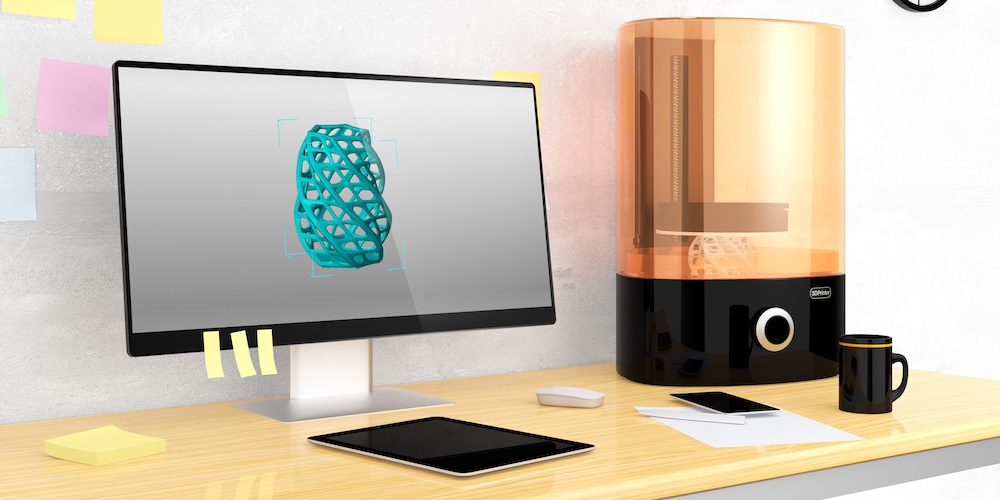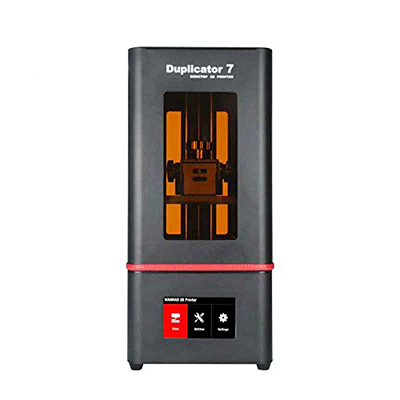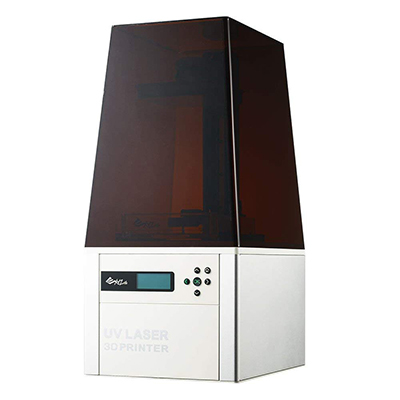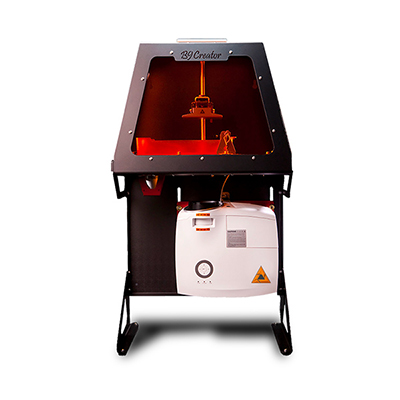Best SLA and Resin 3D Printers of 2019
Stereolithography (SLA) 3D printing is a lot different than Fused Filament Fabrication (FFF) or Fused Deposition Modeling (FDM). Instead of thermoplastic, SLA 3D printers use photopolymer liquid resin. The resin is placed in a vat and then cured by a light source, such as a laser beam or a Digital Light Processing (DLP) projector, causing it to harden and form into a solid object. The process is done layer by layer just like in FFF 3D printing.
SLA or resin 3D printers are known for their ability to produce extremely detailed prints, the kind of results that can make the Ultimaker 3 envious. They are best used for printing RPG miniatures, jewelry prototypes, and other items that require extreme precision and accuracy.
Shopping for the best SLA 3D printers can be just as difficult as shopping for FFF 3D printers, even though there are fewer options to choose from. But with this guide, you can streamline the shopping process and choose from an already curated list of products.
| Budget |
|---|
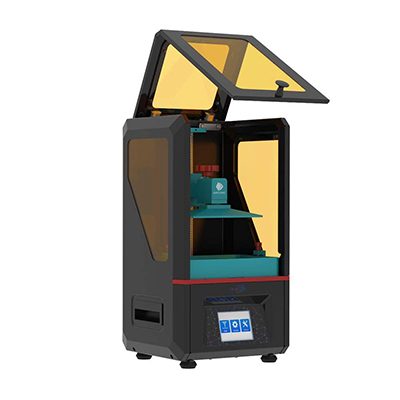 |
| Anycubic Photon |
| 4.2/5.0 |
| 14.6 lb |
| Resolution 25 microns |
| Pre-assembled, enclosed frame, and offline printing. |
| Check Amazon |
| Best Value |
|---|
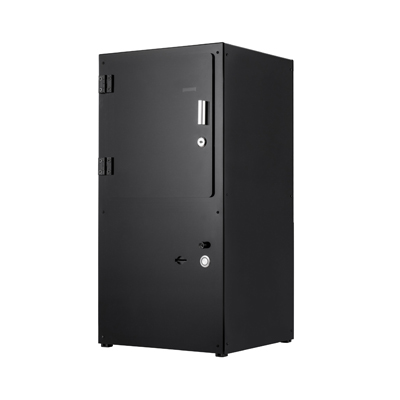 |
| Peopoly Moai |
| 4.5/5.0 |
| 33.1 lb |
| Resolution 10 microns |
| Consistent results even at extreme resolutions. |
| Check Peopoly |
| Top Pick |
|---|
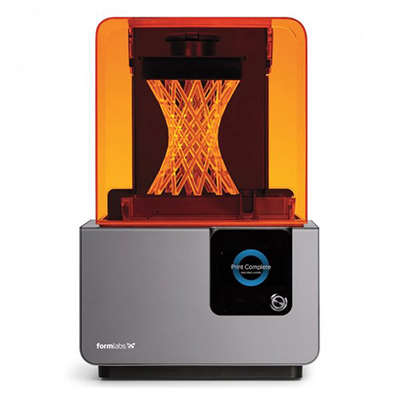 |
| Formlabs Form 2 |
| 4.7/5.0 |
| 28.5 lb |
| Resolution 25 microns |
| Fast print speed and integrated resin system. |
| Check Amazon |
SLA 3D Printers vs. FFF 3D Printers
In this section, we’ll discuss what makes resin 3D printers different from filament 3D printers, from the build volume to the product options. This section is essentially a more detailed list of pros and cons. Consider all of the points mentioned here before you start shopping for the best resin 3D printers.
Layer Resolution
Build Volume
Materials
Ease of Use
Connectivity
Aftermarket Support
Community
Price and Product Options
6 Best SLA 3D Printers Comparison Table
| Make and Model | Resolution | Connectivity | Price |
|---|---|---|---|
| Formlabs Form 2 | 25 microns | Wi-Fi, USB | Check Price |
| Anycubic Photon | 25 microns | USB | Check Price |
| Peopoly Moai | 10 microns | SD card | Check Price |
| Wanhao Duplicator 7 v1.5 | 35 microns | USB | Check Price |
| XYZprinting Nobel 1.0 | 25 microns | USB | Check Price |
| B9Creations B9Creator v1.2 | 5 microns | USB | Check Price |
1. Formlabs Form 2
Editor’s Rating: 4.7/5.0
At the moment, no other desktop SLA 3D printer comes close to the Formlabs Form 2. It’s one of the best consumer 3D printers on the market, especially for professionals. Yes, it’s expensive, selling for well over $3,000, but you definitely get more than what you pay for.
A laser SLA 3D printer, the Form 2 offers many features not seen on most products on the market. It comes assembled, featuring a sturdy frame with an easily removable enclosure and a touchscreen interface at the base. With the intuitive touchscreen interface, you can manage your prints and start prints via Wi-Fi, both of which are convenient functions, most especially the latter.
The Form 2 has an integrated resin system, which allows for seamless operation between prints. More impressively, it can detect the resin type and adjust the settings based on the loaded material. This convenient feature alone should be enough to convince you to buy the Form 2.
Overall, the Form 2 is a top-class desktop SLA 3D printer that offers excellent long-term value. It prints extremely well, prints fast, comes with a large build volume for a desktop resin 3D printer, and has Wi-Fi connectivity. The customer support is great, too. If you have a $5,000 budget for a resin 3D printer, it’s a sin not to consider spending it on the Form 2.
| Tech Specs |
|---|
| Resolution: 25 microns |
| Volume: 5.7 x 5.7 x 6.9 in |
| Weight: 28.5 lb |
| Connect: Wi-Fi, USB |
| The Pros |
|---|
| Generous build volume |
| Intuitive touchscreen interface |
| Fast print speed |
| Integrated resin system |
| Great customer support |
| The Cons |
|---|
| Expensive |
| High operating costs |
2. Anycubic Photon
Editor’s Rating: 4.2/5.0
The Anycubic Photon is proof that resin 3D printers under $1,000 are legit and are capable of producing real results. It’s one of the best 3D printers for miniatures, featuring a relatively easy initial setup and a print quality that will impress even professionals. It sells for around $500, which makes it an appealing product to those who can’t afford to spend thousands of dollars on a resin 3D printer.
The Photon comes assembled out of the box, allowing you to start printing as soon as you finish the initial setup, which isn’t all that difficult as long as you know how to follow instructions. It has a sturdy frame, with a touchscreen interface out front and a USB port for connection. It has a full enclosure, with the door opening upward to give you access to the vat. Many SLA 3D printers require a tethered computer connection to start prints. That’s not the case with the Photon. It supports offline printing via USB, which adds convenience to the user experience.
Like other budget resin 3D printers, the Photon is not a laser SLA 3D printer. To be more accurate, it’s an LCD-based SLA 3D printer, though a lot of people refer to it as a DLP 3D printer. But despite not being a “true” SLA, the Photon is more than capable of printing extremely detailed and smooth 3D models. It can handle geometrically complex 3D models like a champ, even those with lots of tiny details and overhanging parts.
Sadly, the Photon has a very limited build volume. Of the products included here, it has one of the smallest build volumes, one reason some people prefer the similarly priced Wanhao Duplicator 7 v1.5, which offers a bit more print space.
Overall, the Photon is an excellent budget resin 3D printer. It’s relatively easy to use, produces exceptional results, and supports offline printing. If you’re looking to get into SLA 3D printing but don’t want to spend too much on your starter machine, get the Photon.
| Tech Specs |
|---|
| Resolution: 25 microns |
| Volume: 4.5 x 2.6 x 6.1 in |
| Weight: 14.6 lb |
| Connect: USB |
| The Pros |
|---|
| Low price |
| Comes assembled |
| Simple initial setup |
| Enclosed frame |
| Supports offline printing |
| The Cons |
|---|
| Small build volume |
| Limited connection options |
3. Peopoly Moai
Editor’s Rating: 4.5/5.0
The Peopoly Moai is a resin 3D printer that strikes a perfect balance between price and quality. You can get it pre-assembled or in a DIY kit, with the latter selling for about $1,300. We recommend that you go for the user-assembled package as the experience of putting the machine together allows you to learn a great deal about how SLA 3D printing works.
Enclosed with a sturdy frame, the Moai comes in a cabinet-like design, featuring a side-hinged door on the upper half of the frame, where the moving parts are located. (The lower half of the frame contains the main electronics.) It’s made of quality parts, with a well-secured Z axis, which is leadscrew-driven. It has a larger build volume than the Anycubic Photon and prints via G-code, the same format used in FFF 3D printing.
Setting up the Moai kit is not that difficult compared to a Cartesian DIY kit, which can be a nightmare for complete beginners. The Moai has a great community, so you can get lots of advice not only for the initial setup but also for other things, such as the post-print clean-up.
If the Formlabs Form 2 is too expensive for you, check out the Moai before you consider the budget resin 3D printers under $1,000. It’s a great machine that can produce outstanding results, with some people even considering it the true rival to the Form 2, despite not being in the same price range. It has good material compatibility and can print via SD card, the latter of which makes it unique among all the other products included in this guide to the best SLA 3D printers.
| Tech Specs |
|---|
| Resolution: 10 microns |
| Volume: 5.1 x 5.1 x 7.1 in |
| Weight: 33.1 lb |
| Connect: SD card |
| The Pros |
|---|
| Consistent results even at extreme resolutions |
| Good build volume |
| Rigid frame |
| Reasonable price |
| Great community |
| The Cons |
|---|
| Kit doesn’t come with a sample resin |
| Large machine footprint |
4. Wanhao Duplicator 7 v1.5
Editor’s Rating: 4.1/5.0
One of the leading brands when it comes to budget 3D printers, Wanhao offers a nice selection of products under $1,000, including the reliable Wanhao Duplicator i3. The Chinese company doesn’t use Amazon as its main distribution platform in the US, which means you need to be prepared to deal with sellers with questionable business practices.
Of the budget products Wanhao offers, the Wanhao Duplicator 7 v1.5 easily stands out, obviously because it’s a resin 3D printer. Like the Anycubic Photon, this one is an LCD-based SLA 3D printer, selling for a similar price at around $500. Because they belong in the same price range, the Photon and the Duplicator 7 v1.5 are often compared with each other.
The Duplicator 7 v1.5 offers a slightly larger build envelope than the Photon, featuring a taller frame, which allows for more vertical space. It comes assembled and has an easy initial setup, similar to the Photon. It has a full enclosure, but unlike with the Photon, the enclosure doesn’t have a hinged opening for easy access to the vat. Instead, the enclosure needs to be completely removed — a minor inconvenience that most people probably won’t mind.
In regard to overall performance, the Duplicator 7 v1.5 is about on the same level as the Photon, although it has a lower max layer resolution. It can print stunningly beautiful and clean prints, especially when the settings are optimized. It has a fair print speed for a resin 3D printer and comes with a better cooling system than previous iterations of the product.
All in all, the Duplicator 7 v1.5 is a great 3D printer. It has an active community, works fine with minimal tinkering out of the box, and offers a larger build volume than the Photon. If you want a bit more build space, especially vertically, go for the Duplicator 7 v1.5. Just don’t expect top-class customer service from Wanhao as the Chinese manufacturer is unreliable on the front.
| Tech Specs |
|---|
| Resolution: 35 microns |
| Volume: 4.7 x 2.7 x 7.9 in |
| Weight: 26.5 lb |
| Connect: USB |
| The Pros |
|---|
| Comes assembled |
| Great community |
| Good build volume for an SLA |
| Improved frame stability |
| Better cooling system than previous models |
| The Cons |
|---|
| Limited connection options |
| Unreliable Wanhao customer service |
5. XYZprinting Nobel 1.0
Editor’s Rating: 3.9/5.0
XYZprinting is one of the more polarizing brands in the business. On one hand, the company offers a nice selection of products, from 3D printers designed for kids to multi-color 3D printers. But on the other hand, the company is notorious for its use of proprietary printing materials. The good news is that the XYZprinting Nobel 1.0 is not one of the products restricted to first-party materials.
Although the Nobel 1.0A is now out on the market, there are a couple of solid reasons the Nobel 1.0 is the more recommended product, especially for beginners. First, the Nobel 1.0A sells for almost $2,000, making it even more expensive than the Peopoly Moai, which is the better machine. The Nobel 1.0 sells for around $900. And second, the Nobel 1.0A seems to be always out of stock, both on Amazon and at the XYZprinting US store.
The Nobel 1.0 comes assembled out of the box, with a straightforward initial setup that takes less than one hour. It includes everything you need to get started right away, including a bottle of sample resin. It has an easily removable enclosure for safety and an LCD interface at the base. The Nobel 1.0 supports offline printing via USB – which is more convenient than a cabled computer connection – and features an auto resin refill system.
The Nobel 1.0 works great out of the box. It can produce exceptional prints, though the print speed is unimpressive. It can easily handle small 3D models but seems to run into quality issues when printing with large 3D models. As mentioned, the Nobel 1.0 is not restricted to XYZprinting materials. It can use compatible resins from other brands, though, as expected, it works best when working with XYZprinting resins.
Don’t let the company reputation discourage you from giving the Nobel 1.0 a chance. It’s a solid 3D printer that offers good long-term value. It has a good build volume and a simple initial setup and can use third-party resin – all of which makes it well worth the money.
| Tech Specs |
|---|
| Resolution: 25 microns |
| Volume: 5 x 5 x 7.9 in |
| Weight: 21.2 lb |
| Connect: USB |
| The Pros |
|---|
| Simple initial setup |
| Auto resin refill system |
| Great build volume |
| Beginner-friendly software |
| Open resin system |
| The Cons |
|---|
| Relatively slow print speed |
| Optimized for XYZprinting resins |
6. B9Creations B9Creator v1.2
Editor’s Rating: 4.5/5.0
A 3D printer with Kickstarter origins, the B9Creator v1.2 from B9Creations is a powerful DLP 3D printer designed for both serious hobbyists and businesses. It sells for about $4,600, making it even more expensive than the Formlabs Form 2.
In terms of design, this resin 3D printer has a rather odd structure, especially compared to the other products in this guide to the best SLA 3D printers. It looks like an amateur science experiment than a functional machine. The upper half of the frame houses the print area, which is enclosed, while the lower half is reserved for the DLP projector. It can print via a USB connection and use resins from other brands.
The B9Creator v1.2 is notable for its relatively low running costs compared to other resin 3D printers. This is what makes it an appealing machine for commercial use. It can produce extremely detailed prints in a consistent manner and with a low failure rate. It has a good community, with B9Creations also providing outstanding customer support.
Versatile and reliable, the B9Creator v1.2 is one of those products that won’t make you regret your purchase, especially if you plan to use it for commercial use. As expected, it has a steep learning curve, but the manufacturer puts in the effort to guide its customers in the beginning. While it has a small build volume overall, this resin 3D printer offers the most vertical space out of all the products on this list, edging out the XYZprinting Nobel 1.0 by a hair.
| Tech Specs |
|---|
| Resolution: 5 microns |
| Volume: 4.1 x 3 x 8 in |
| Weight: 29.8 lb |
| Connect: USB |
| The Pros |
|---|
| Consistent and reliable |
| Open material system |
| Relatively low operating costs |
| Good community |
| Outstanding customer service |
| The Cons |
|---|
| Unappealing design |
| Expensive |
Contents
- SLA 3D Printers vs. FFF 3D Printers
- Layer Resolution
- Build Volume
- Materials
- Ease of Use
- Connectivity
- Aftermarket Support
- Community
- Price and Product Options
- 6 Best SLA 3D Printers Comparison Table
- 1. Formlabs Form 2
- 2. Anycubic Photon
- 3. Peopoly Moai
- 4. Wanhao Duplicator 7 v1.5
- 5. XYZprinting Nobel 1.0
- 6. B9Creations B9Creator v1.2

